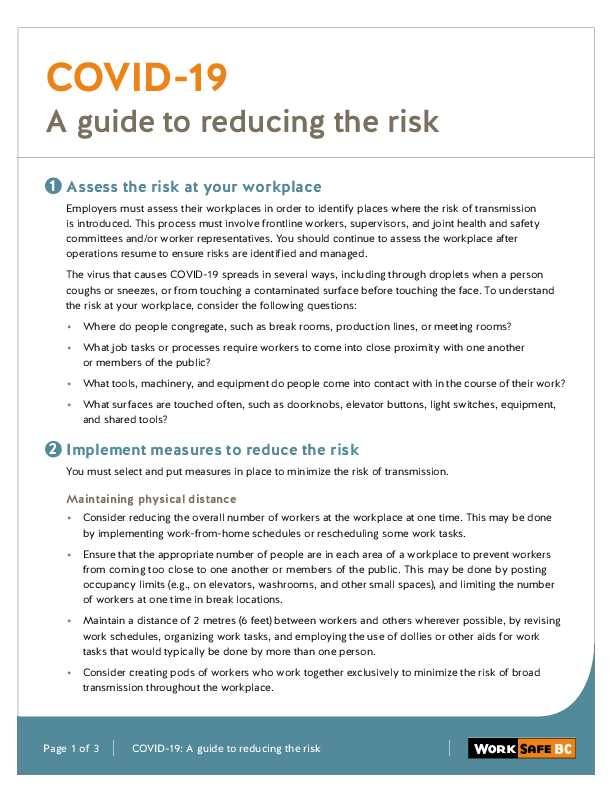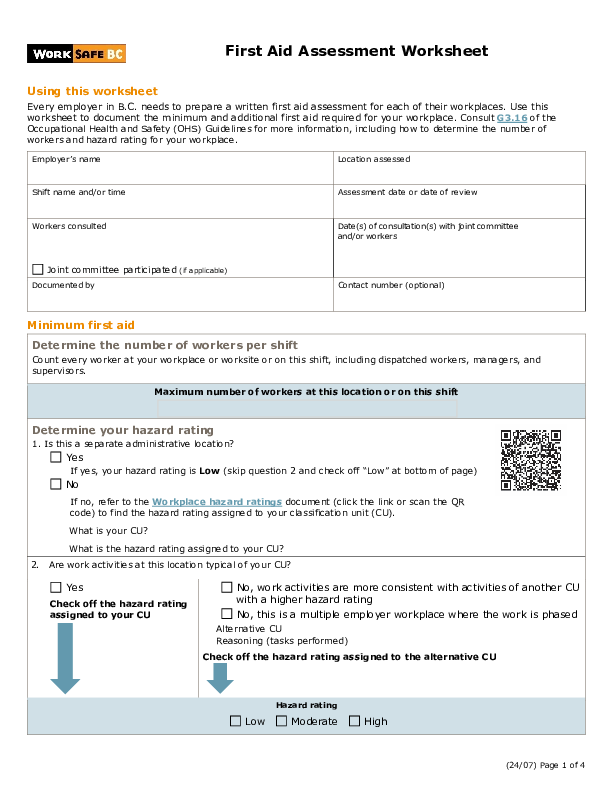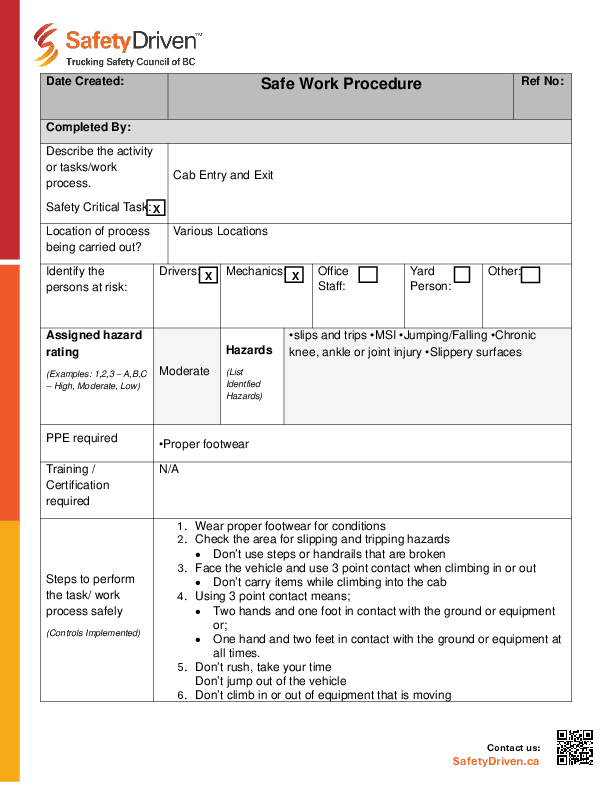
Guide to Reducing the Risk of COVID-19
WorkSafeBC recognizes the importance of worker safety as businesses look to resume operations following COVID-19 related work stoppages or interruptions. The following materials provide employers with information and resources to assist them in ensuring the risk of exposure to the virus that causes COVID-19 is minimized at their workplace.
1. Assess the risk at your workplace
Employers must assess their workplaces in order to identify places where the risk of transmission is introduced. This process must involve frontline workers, supervisors, and joint health and safety committees and/or worker representatives. You should continue to assess the workplace after operations resume to ensure risks are identified and managed.
The virus that causes COVID-19 spreads in several ways, including through droplets when a person coughs or sneezes, or from touching a contaminated surface before touching the face. To understand the risk at your workplace, consider the following questions:
- Where do people congregate, such as break rooms, production lines, or meeting rooms?
- What job tasks or processes require workers to come into close proximity with one another or members of the public?
- What tools, machinery, and equipment do people come into contact with in the course of their work?
- What surfaces are touched often, such as doorknobs, elevator buttons, light switches, equipment, and shared tools?
2. Implement measures to reduce the risk
You must select and put measures in place to minimize the risk of transmission.
Maintaining physical distance
- Consider reducing the overall number of workers at the workplace at one time. This may be done by implementing work-from-home schedules or rescheduling some work tasks.
- Ensure that the appropriate number of people are in each area of a workplace to prevent workers from coming too close to one another or members of the public. This may be done by posting occupancy limits (e.g., on elevators, washrooms, and other small spaces), and limiting the number of workers at one time in break locations.
- Maintain a distance of 2 metres (6 feet) between workers and others wherever possible, by revising work schedules, organizing work tasks, and employing the use of dollies or other aids for work tasks that would typically be done by more than one person.
- Consider creating pods of workers who work together exclusively to minimize the risk of broad transmission throughout the workplace.
- Implement measures to ensure workers can maintain a distance of two metres when serving or working with or near members of the public.
Where physical distance cannot be maintained
- Where distance cannot be maintained, consider separating people with partitions or plexiglass barriers.
- Where other measures are not sufficient, consider the use of non-medical masks, understanding that these have limitations.
Cleaning and hygiene
- Provide adequate hand-washing facilities on site for all workers and ensure the location is visible and easily accessed. Develop policies around when workers must wash their hands, including upon arriving for work, before and after breaks, after handling cash or other materials, before and after handling common tools and equipment.
- Implement a cleaning protocol for all common areas and surfaces, including washrooms, equipment, tools, common tables, desks, light switches, and door handles. Ensure those engaged in cleaning have adequate training and materials.
- Remove any unnecessary tools or equipment that may elevate the risk of transmission, including items like coffee makers and shared utensils and plates.
3. Develop policies
Develop the necessary policies to manage your workplace, including policies around who can be at the workplace, how to address illness that arises at the workplace, and how workers can be kept safe in adjusted working conditions.
- The provincial health officer and the BC CDC have issued the following guidance around self-isolation, which must be reflected in your policies:
-
anyone who has had symptoms of COVID-19 in the last 10 days must self-isolate at home; symptoms include fever, chills, new or worsening cough, shortness of breath, sore throat and new muscle aches or headache.
- anyone under the direction of the provincial health officer to self-isolate must follow those instructions
- anyone who has arrived from outside of Canada, or who is a contact of a confirmed COVID-19 case, to self-isolate for 14 days and monitor for symptoms
-
- Prohibit or limit visitors.
- Have a plan around workers who may start to feel ill while at work, including who they should notify and how they will travel from the workplace to their home.
- Will you have workers working alone to reduce the risk of transmission? If so, you need to have procedures for these workers to ensure they are safe.
- If you will have employees working from home, you need to develop work from home procedures to ensure workers are working safely.
4. Develop communication plans and training
You must ensure that everyone entering the workplace, including workers from other employers, knows how to keep themselves safe while at your workplace.
- Be sure everyone is trained on the measures you have put in place and the policies around staying home when sick.
- Post signage, including occupancy limits and effective handwashing practices. Signage should also be posted at the main entrance indicating who is restricted from entering the premises (including visitors and workers with symptoms).
- Ensure supervisors have been trained on monitoring workers and workplace to ensure policies and procedures are being followed.
5. Monitor your workplace and update your plans as needed
- Things may change as your business operates. If you identify a new area of concern, or if it seems like something isn’t working, take steps to update your policies and procedures. Involve workers in this process.
- Ensure that workers can raise safety concerns. This may be through a worker health and safety representative or a joint health and safety committee. Employers with fewer than 9 employees must also have a way for workers to raise health and safety concerns at the workplace. Work with these committees and workers to resolve any identified safety issues.
6. Assess and address risks from resuming operations
If your workplace has not been operating, there may be risks arising from restarting your business that you need to manage. Consider the following:
- Have you had any staff turnover, or are workers being required to change or adapt job roles, or to use new equipment? Consider training or new employee orientation.
- Will workers need time or training to refresh their skills after having been out of the workplace?
- Have you changed anything about the way you operate, such as the equipment you use or the products you create?
- Are there any processes required for start-up that might introduce risks? Consider the impact of restarting machinery, tools and equipment, or clearing systems and lines of product that may have been left when your business was closed.
Trucking and Moving & Storage specific resources available here
Please check the WorkSafeBC website for the most current version of this resource.
Latest Resources
First Aid Assessment Worksheet
Every employer in B.C needs to prepare a written first aid assessment for each of the ...
Safe Work Procedure: Cab Entry & Exit
An Employer can make use of a safe work procedure (SWP) by training new and existing ...

